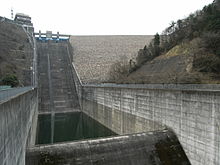Akigawa Dam
| Agigawa Dam | |
|---|---|
 |
|
| Location | Higashino-Yamamoto section, Ena City, Gifu Prefecture, Japan |
| Coordinates | 35°25′29″N 137°25′48″E / 35.424722°N 137.43°ECoordinates: 35°25′29″N 137°25′48″E / 35.424722°N 137.43°E |
| Construction began | 1969 |
| Opening date | 1990 |
| Dam and spillways | |
| Type of dam | Central rock-filled impermeable embankment dam |
| Impounds | Agigawa River, Kisogawa River water system |
| Height | 101.5 m |
| Length | 362 m |
| Dam volume | 4,900,000 m³ |
| Reservoir | |
| Creates | Agigawako Lake |
| Total capacity | 48,000,000 m³ total, 44,000,000 m³ active |
| Catchment area | 81.8 km² |
| Surface area | 158.0 ha |
| Power station | |
| Operator(s) | Japan Water Agency |
| Installed capacity | Agigawa River Generation Plant: 2,600 kW |
| Purposes: Flood control, unspecified water use, tap water, industrial water | |
Agigawa Dam (阿木川ダム Agigawa damu?) is a dam built on the Kisogawa River system, located in the Higashino section of Ena City, in Gifu Prefecture, Japan.
The Agigawa (river) connects with the Kiso River just below Ōi Dam, running through a basin with a fairly large 2,000 mm of annual rainfall, and has long been used by Gifu Prefecture's Tōnō region (which includes the cities of Ena, Gifu, Ena and Nakutsugawa) for tap water and industrial-use water. However, in times of heavy rainfall, Agigawa River would quickly overflow, flooding the surrounding area. The river flows through Ena City, making levee construction difficult; the Chūō Expressway and the Central Japan Railway Company's Chūō Main Line also cross the river, which led to increased demand for safe flood control measures.
Demand for tap water for Nagoya and the Chūkyō Metropolitan Area's postwar population boom, as well as industrial-use water for the Tōkai and Chūkyō Industrial Areas also rose. Attempts to meet water demand for Aichi Prefecture came up short, with the Makio Dam on the Ōtaki River alone proving insufficient. Water was also in short supply in Gifu Prefecture's Tōnō region, centering on Tajimi City, sometimes escalating to drought. Existing water rights and hydroelectricity-use water rights were given priority, precluding the possibility of siphoning off water from the middle of the river, and forcing the creation of multiple small reservoirs.
...
Wikipedia
